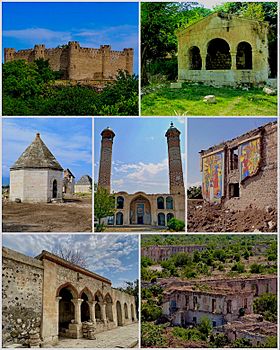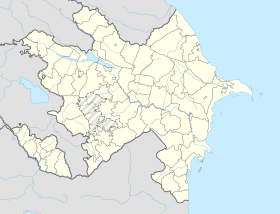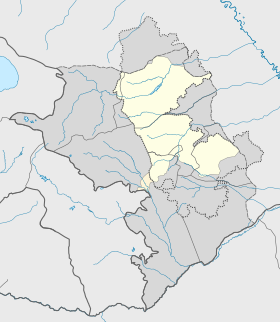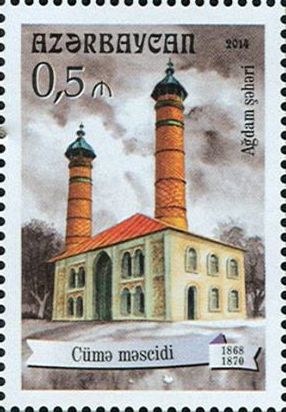Aghdam facts for kids
Quick facts for kids
Aghdam
Ağdam
|
|
|---|---|

From top left:
|
|
| Country | |
| District | Aghdam |
| Elevation | 369 m (1,211 ft) |
| Population
(1989)
|
|
| • Total | Currently uninhabited Pre-war population was 28,031 |
| Time zone | UTC+4 (AZT) |
Aghdam (Azerbaijani: Ağdam) is a ghost town in Azerbaijan. It is the main town of the Aghdam District. The town was founded in the 18th century. It became a city in 1828 and grew a lot during the time of the Soviet Union. Aghdam is about 26 kilometers from Stepanakert. It sits at the eastern base of the Karabakh Range.
Before the First Nagorno-Karabakh War, Aghdam had many factories. These included places that made butter, wine, and brandy. There were also machine and silk factories. The city had an airport and two railway stations. By 1989, about 28,031 people lived there. In July 1993, during the war, Armenian forces took control of Aghdam. The fighting made everyone living there leave their homes. The town was badly damaged and became mostly empty. Until 2020, it was part of the Nagorno-Karabakh Republic.
In November 2020, Aghdam and its nearby areas returned to Azerbaijani control. This happened as part of a peace agreement that ended the 2020 Nagorno-Karabakh war. The Azerbaijani government started allowing tourists from Azerbaijan to visit the town in 2022.
Contents
What Does Aghdam Mean?
The name Aghdam comes from the Azerbaijani language. It means "white house." The word ağ means "white." The word dam means "house" or "attic." So, it means a "bright, sun-lit, white house." This name was given by Panah Ali Khan of the Karabakh Khanate. He named it after the Imarat cemetery. Some Azerbaijani writers also think it might come from old Turkic languages. In those languages, it could mean "small fortress."
In November 2010, the authorities who controlled the town renamed it Akna (Armenian: Ակնա). This name was used until 2020.
Aghdam's Story
Early Days
Aghdam is near Tigranakert of Artsakh. This was an old Armenian city. It dates back to the 2nd–1st centuries B.C.
Aghdam was started in the middle of the 18th century. It was where Panah Ali Khan Javanshir had his summer palace. It was also the burial place for the Javanshir clan family. In 1828, it became a city. During the Soviet era, Aghdam was an industrial center. It had factories for butter, wine, brandy, and silk. There were also factories for hardware and tools. The city had an airport and two train stations. Aghdam also had schools for technical skills, farming, medicine, and music.
The First Nagorno-Karabakh War
Aghdam saw heavy fighting during the First Nagorno-Karabakh War. Azerbaijani forces used Aghdam as a base. They launched rockets and bombs from there. Armenian forces also shelled Aghdam.
In July 1993, Armenian forces took control of Aghdam. When the city fell, all its people had to leave. They fled to the east. After the city was captured, it was damaged and burned. Many buildings were destroyed. The city became a "buffer zone." This means it was an empty area between two sides. Because of this, Aghdam was empty and decaying until November 2020. It was usually not open for visitors.
Many houses in the town were destroyed. This was done to stop people from returning. The city has sometimes been called the Hiroshima of the Caucasus. This name shows how much it was destroyed.
Under Armenian Control
The ruined city once had almost 30,000 people. But it became an almost completely empty ghost town. A group that visited in 2005 reported that the whole town was "in complete ruins." Only the mosque in the center was still standing. People were taking building materials from the town. The city was destroyed "brick by brick," not just in fighting.
The Aghdam mosque was the only building left. It was damaged with graffiti. It was also used to keep cows. Aghdam's cemeteries were also destroyed. This included the old 18th-century tombs at Imarat Garvand. Graves were dug up, and only one damaged tombstone remained.
In 2007, a photographer visited Aghdam. He reported that the mosque floor was covered in cow manure. His pictures showed cattle inside the mosque. Its bad condition made people from Azerbaijan and Turkey upset. They wrote a letter in 2010 asking for help. In 2009, officials said the mosque's roof was fixed. They also said the area around it was cleaned. In 2010, the government of Artsakh announced that the mosque was cleaned. They also said it was refurbished. However, a journalist who visited in 2011 posted photos. These photos showed the mosque still had no roof. They also showed its "neglected and damaged interior."
Return to Azerbaijan
Aghdam and its surrounding area returned to Azerbaijani control. This happened on November 20, 2020. It was part of the agreement that ended the 2020 Nagorno-Karabakh War. On November 24, 2020, President Ilham Aliyev visited the ruined city. He gave a speech there. Soon after, work began to clean up the city. The government thinks it will take 2–5 years for people to live there again. They also think it will take 15 years to remove all landmines.
Rebuilding Aghdam
In May 2021, news came out about plans to rebuild Aghdam's city center. Work also started on a road between Barda and Aghdam. On May 28, President Ilham Aliyev visited the city again. He announced that rebuilding had begun. He laid the first stones for a new school, a "Victory Museum," and an "Open Air Occupation Museum." He also laid stones for an "Industry Park" and the first new homes. He visited the Panah Ali Khan palace and the Imarat tombs.
The plan for the city is to combine eight nearby villages with Aghdam. This would make the population around 100,000 people. The new homes will be multi-story buildings and private houses. The city will have many gardens. It will be rebuilt as a "smart city." This means it will use new technology. It will also be a "green energy zone." This means it will use clean energy. The city will have a large green area of 125 hectares. There will also be an artificial lake, canals, and bridges. New roads, paths for walking and biking, and electric public transport are also planned.
Aghdam's Weather
Aghdam has a cold semi-arid climate. This means it is dry and has cold winters.
| Climate data for Agdam | |||||||||||||
|---|---|---|---|---|---|---|---|---|---|---|---|---|---|
| Month | Jan | Feb | Mar | Apr | May | Jun | Jul | Aug | Sep | Oct | Nov | Dec | Year |
| Mean daily maximum °C (°F) | 6.2 (43.2) |
7.0 (44.6) |
11.2 (52.2) |
18.6 (65.5) |
23.1 (73.6) |
27.8 (82.0) |
31.3 (88.3) |
30.1 (86.2) |
25.9 (78.6) |
19.1 (66.4) |
13.0 (55.4) |
8.6 (47.5) |
18.5 (65.3) |
| Daily mean °C (°F) | 2.3 (36.1) |
2.8 (37.0) |
6.1 (43.0) |
12.3 (54.1) |
16.1 (61.0) |
20.4 (68.7) |
24.6 (76.3) |
23.3 (73.9) |
18.6 (65.5) |
13.5 (56.3) |
8.2 (46.8) |
4.1 (39.4) |
12.7 (54.9) |
| Mean daily minimum °C (°F) | −0.9 (30.4) |
0.0 (32.0) |
3.2 (37.8) |
8.9 (48.0) |
13.5 (56.3) |
17.8 (64.0) |
21.2 (70.2) |
20.0 (68.0) |
16.4 (61.5) |
10.6 (51.1) |
5.8 (42.4) |
1.5 (34.7) |
9.8 (49.6) |
| Average precipitation mm (inches) | 15 (0.6) |
24 (0.9) |
32 (1.3) |
48 (1.9) |
73 (2.9) |
64 (2.5) |
33 (1.3) |
27 (1.1) |
30 (1.2) |
50 (2.0) |
32 (1.3) |
19 (0.7) |
447 (17.6) |
| Average precipitation days | 4 | 6 | 7 | 7 | 10 | 7 | 3 | 3 | 4 | 6 | 5 | 4 | 66 |
| Source: NOAA | |||||||||||||
Who Lived in Aghdam?
Before the war, many people lived in Aghdam. The table below shows how the population changed over time.
| Year | Population | Main Ethnic groups | Source |
|---|---|---|---|
| 1908 | 931 | Mostly Tatars (later known as Azerbaijanis) | Caucasian Calendar |
| 1923 | 1,660 | ||
| 1926 | 7,910 | 93.6% Turks (i.e. Azerbaijani) | Soviet census |
| 1939 | 10,746 | 83.3% Azerbaijani, 8.7% Russian, 5.3% Armenian | Soviet census |
| 1959 | 16,061 | 92% Azerbaijani, 3.6% Russian, 3.4% Armenian | Soviet census |
| 1970 | 21,277 | 94.9% Azerbaijani, 2% Russian & Ukrainian, 2% Armenian | Soviet census |
| 1979 | 23,483 | 97% Azerbaijani, 1.3% Russian & Ukrainian, 1.2% Armenian | Soviet census |
| 1989 | 28,031 | Soviet census | |
| 1993 | Armenian forces took control. The Azerbaijani people left. | ||
| 2005 | 0 | ||
What Aghdam Made
Before the First Nagorno-Karabakh War, Aghdam had many factories. These included places that made butter, wine, and brandy. There were also machine factories and a railway station in the city.
Culture in Aghdam
Music and Media
Mugham music is a special kind of music from the Karabakh region. It was an important part of Aghdam's culture. The city had an Aghdam Mugham School. It also had a music group called "Karabakh nightingales."
Sports
A football team used to be based in Aghdam. This team is now based in Baku. It plays in the Azerbaijan Premier League under the name Qarabağ FK. The Imarat Stadium was destroyed during the First Nagorno-Karabakh War.
Getting Around Aghdam
Before the war, the city had bus and tram lines. It also had an airport. None of these work now. In November 2020, Azerbaijan Railways said they were planning to build a new railway line. This line would go from Yevlakh to Stepanakert through Aghdam. It would be about 104 kilometers long.
Schools in Aghdam
Before the city was destroyed, it had 74 schools. None of these schools are working now.
Famous People from Aghdam
Some well-known people used to live in Aghdam. These include military commanders Allahverdi Baghirov and Asif Maharammov. Footballers like Ramiz Mammadov, Mushfig Huseynov, and Vüqar Nadirov are also from Aghdam. Famous mugham singers include Gadir Rustamov, Mansum Ibrahimov, Arif Babayev, and Sakhavat Mammadov. Other notable residents are actor Jeyhun Mirzayev, scientist Zakir Mammadov, writer Nushaba Mammadli, and singers Roya and Günel Zeynalova.
See Also
 In Spanish: Agdam (ciudad) para niños
In Spanish: Agdam (ciudad) para niños
- Agdam Tea House
- Aghdam Bread Museum
- Panah Ali Khan's Palace
- Otuzikilar district





